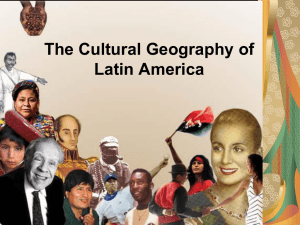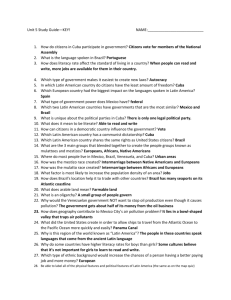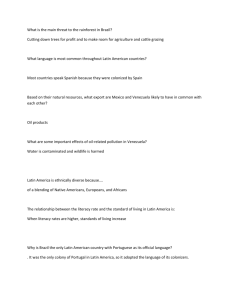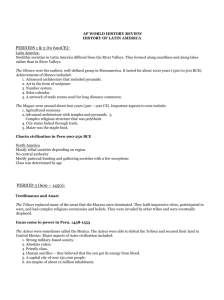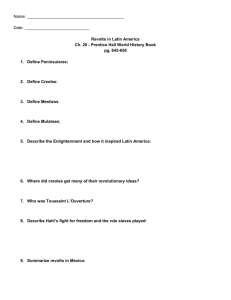AP WORLD HISTORY REVIEW HISTORY OF LATIN AMERICA FOUNDATIONS PERIOD:
advertisement
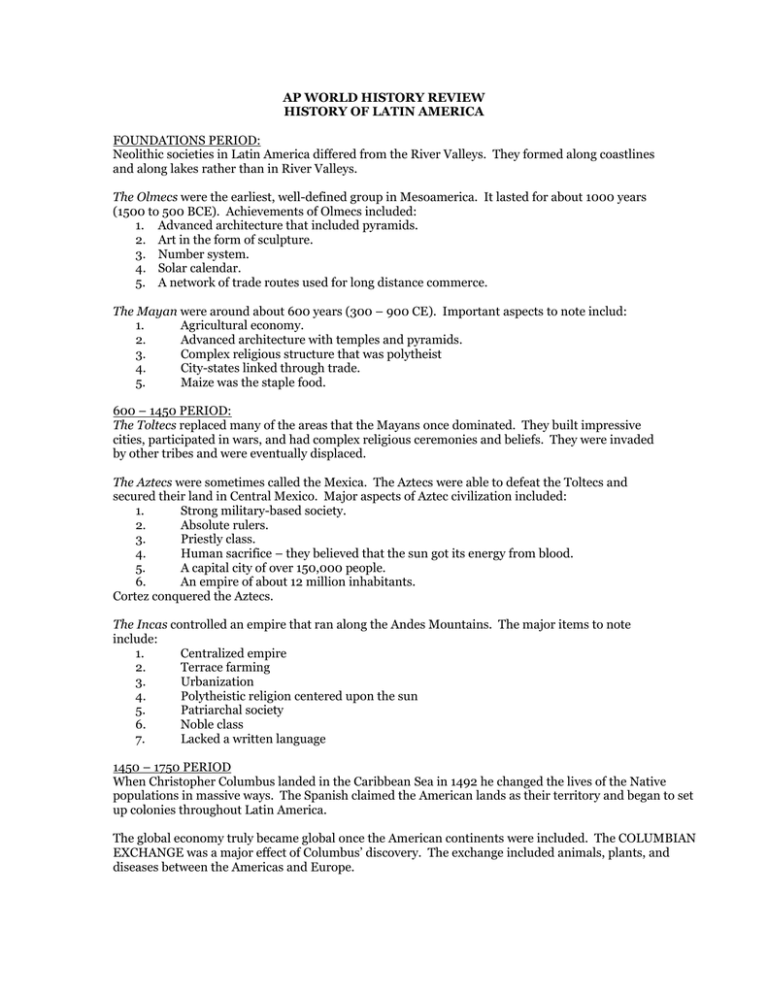
AP WORLD HISTORY REVIEW HISTORY OF LATIN AMERICA FOUNDATIONS PERIOD: Neolithic societies in Latin America differed from the River Valleys. They formed along coastlines and along lakes rather than in River Valleys. The Olmecs were the earliest, well-defined group in Mesoamerica. It lasted for about 1000 years (1500 to 500 BCE). Achievements of Olmecs included: 1. Advanced architecture that included pyramids. 2. Art in the form of sculpture. 3. Number system. 4. Solar calendar. 5. A network of trade routes used for long distance commerce. The Mayan were around about 600 years (300 – 900 CE). Important aspects to note includ: 1. Agricultural economy. 2. Advanced architecture with temples and pyramids. 3. Complex religious structure that was polytheist 4. City-states linked through trade. 5. Maize was the staple food. 600 – 1450 PERIOD: The Toltecs replaced many of the areas that the Mayans once dominated. They built impressive cities, participated in wars, and had complex religious ceremonies and beliefs. They were invaded by other tribes and were eventually displaced. The Aztecs were sometimes called the Mexica. The Aztecs were able to defeat the Toltecs and secured their land in Central Mexico. Major aspects of Aztec civilization included: 1. Strong military-based society. 2. Absolute rulers. 3. Priestly class. 4. Human sacrifice – they believed that the sun got its energy from blood. 5. A capital city of over 150,000 people. 6. An empire of about 12 million inhabitants. Cortez conquered the Aztecs. The Incas controlled an empire that ran along the Andes Mountains. The major items to note include: 1. Centralized empire 2. Terrace farming 3. Urbanization 4. Polytheistic religion centered upon the sun 5. Patriarchal society 6. Noble class 7. Lacked a written language 1450 – 1750 PERIOD When Christopher Columbus landed in the Caribbean Sea in 1492 he changed the lives of the Native populations in massive ways. The Spanish claimed the American lands as their territory and began to set up colonies throughout Latin America. The global economy truly became global once the American continents were included. The COLUMBIAN EXCHANGE was a major effect of Columbus’ discovery. The exchange included animals, plants, and diseases between the Americas and Europe. The Spanish set up Latin America into numerous plantations. These plantations needed large labor supplies. At first, Native Americans were forced to work on plantations, but they soon succumb to disease. De la Casas, a priest, suggested that the Spanish import slaves from Africa since they did not die from European diseases. The largest number of slaves from Africa was sent to Latin America. In addition to agriculture, the Spanish began mining for gold and silver (Mexico and Peru). The amount of silver mined from Spain was so great that the final of silver in Europe declined. Native Americans worked in mines until African slaves began to replace them. Mines were owned privately, but they had to send 20% to the Spanish government. The Spanish in Latin America led to an exchange of culture that hadn’t been seen since the Roman and Islamic Empires. The Spanish language, religion (Catholicism), and social structure were spread to both the Natives of Latin America and the immigrants who arrived. The social and labor system in Latin America was called the Encomienda System. The institution was much in decline by the 1620s. Despite the disappearance of the encomienda, the royal government continued to exact Indian labor as a form of taxation, the mita. During the seventeenth century, Indians began to leave villages and seek private employment as a means of avoiding government labor requirements. The Portuguese also sought land in the Americas and they were guaranteed Brazil in the Line of Demarcation (Treaty of Tordesillas). Brazil’s economy was based upon sugar and mining. They also used slaves for the majority of their labor needs. There was great competition between Brazil and the Caribbean in the sugar market. To ensure that there were enough slaves for Brazil, Portugal outlawed slavery within the country of Portugal. SOCIAL AND GOVERNMENTAL SYSTEM The Viceroys ruled the Spanish colonies. He was both the administrative and the military leader of the colony. He collected taxes and performed the duties of judges. The multi-ethnicity of Latin America was the most diverse in the world. First social structure did exist that greatly limited some people. The system that emerged was: • Peninsulares – those born in Europe • Creoles – those born in the Americas, but to European parents; the lack of status and rights for this group led to dissent and eventual rebellion • Mestizoes and other mixed race individuals were at the bottom of the structure. • Women did have rights in dowry, inheritance, and some access to commerce. 1750 – 1914: Revolutionary ideas from the United States and Europe inspired a wave of revolutions across Latin America. Two early but unsuccessful revolts occurred in 1781 in New Granada (The Comunero Revolt) and it Peru (led by Tupac Amaru). Racial divisions between the rebels proved to be their major downfall. Revolution Haiti Year 1791 Venezuela and Columbia 1820 Brazil 1822 Leaders and Events/Results Toussaint-Louverture (the Black Washington) First successful slave uprising Eventual freedom from France and the France sell Louisiana San Martin and Simon Bolivar led revolts against Spain in the northern part of South America. Appealed to all classes In 1807 the Portuguese royal family fled Napoleonic troops in Europe and moved to Brazil Leads to desire for independence from Portugal Prince Dom Pedro I declares independence from his father’s Mexico 1823 Portugal in 1822 Bloodless 1810 Started out as a class revolt by the peasants who wanted land; Bloody class struggle led by Father Miguel de hidalgo who appealed to the mestizos and Natives Creoles become involved in the struggle in 1820 Leads to Mexico becoming a republic Other Major Events During This Time: • Latin America began to outlaw slavery; Brazil was the last in 1888 • Catholic Church remained the dominant influence in LA • Creoles enjoyed voting rights but Natives, Mestizoes, blacks, and women did not • Governments were mainly unstable with dictators becoming the norm (included the “enlightened” Bolivar); most were wealthy landowners • Caudillos – regional military figures – dominated many areas and normally appealed to the poor • Spain remained in Cuba and Puerto Rico until the Spanish American War • Large numbers of European immigrants continued to move to Brazil and Argentina while Mexico and Central America’s immigration era ended Latin American Economies Great Britain was the major trading power with Latin America. Latin America free trade led to an increase of state improvements, such as roads and railroads, but the world demanded Latin American raw materials – not industrial products. Many countries relied on just a few agricultural products to trade with the world market – coffee, bananas, cattle, etc. Political Movements Mexico still had major problems with land distribution and the lack of rights for Natives. This led to an appeal for strong military leadership. This included Santa Anna who lost power because of international issues (Texas Revolution and Mexican American War. The landowners sought help from France who overthrow the republic and placed the Austrian Habsburg Maximillian on the throne as emperor. When France left Mexico, Maximillian was overthrown and Benito Juarez ruled Mexico until 1872. Universal male suffrage was given. Landowners opposed reforms. Mexican Revolution – 1911 – 1920 • Another Class Conflict, only 5% owned land • A mixture of peasants, workers, and the Middle Class overthrew Dictator Porfirio Diaz. • Conflict between groups led to popular uprisings in countryside • Emiliano Zapata and Pancho Villa led popular uprisings. • 1917 Constitution led to more reforms Latin America continued to be defined by ethnic issues. Argentine Gauchos (cowboys) brought some rights to fellow mestizos and castizos. Male dominated society that did not allow for women suffrage movements or female education. 1914 – Present United States’ desire for a Panama Canal to increase trade led to support for Colombian rebels who declared an independent Panama and allowed the U.S. to build the canal in 1914. Major events and trends: • Mexican redistribution of land • Mexico dominated by PRI (Institutional Revolutionary Party) • • • Argentina military rule (Peronistas) Mixture of free elections and military dictators Cold War led to increased U.S. involvement in Central America o U.S. helped overthrew socialists and communists learning governments in Guatemala and Nicaragua o Anti-Cuban policies and events included the overthrow of Batista in 1959 Cuba becoming a communist country under Castro. U.S. placed embargos on Cuba, organized Bay of Pigs, and confronted the Soviet Union over missiles in Cuba (closest the U.S. ever came to nuclear warfare) Latin America remains a region that is economically and politically challenged. Democracy and capitalism is expanding in many areas.
